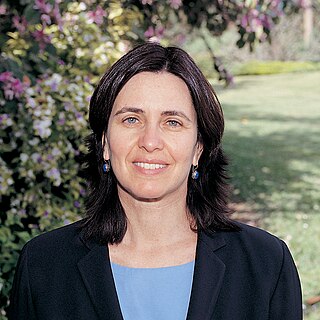Related Research Articles

A digital signature is a mathematical scheme for verifying the authenticity of digital messages or documents. A valid digital signature, where the prerequisites are satisfied, gives a recipient very high confidence that the message was created by a known sender (authenticity), and that the message was not altered in transit (integrity).

In theoretical computer science and cryptography, a trapdoor function is a function that is easy to compute in one direction, yet difficult to compute in the opposite direction without special information, called the "trapdoor". Trapdoor functions are a special case of one-way functions and are widely used in public-key cryptography.
Articles related to cryptography include:
In computer science, a one-way function is a function that is easy to compute on every input, but hard to invert given the image of a random input. Here, "easy" and "hard" are to be understood in the sense of computational complexity theory, specifically the theory of polynomial time problems. Not being one-to-one is not considered sufficient for a function to be called one-way.
A commitment scheme is a cryptographic primitive that allows one to commit to a chosen value while keeping it hidden to others, with the ability to reveal the committed value later. Commitment schemes are designed so that a party cannot change the value or statement after they have committed to it: that is, commitment schemes are binding. Commitment schemes have important applications in a number of cryptographic protocols including secure coin flipping, zero-knowledge proofs, and secure computation.

A cryptographic hash function (CHF) is a hash algorithm that has special properties desirable for a cryptographic application:
The Rabin cryptosystem is a family of public-key encryption schemes based on a trapdoor function whose security, like that of RSA, is related to the difficulty of integer factorization.
In cryptography, GMR is a digital signature algorithm named after its inventors Shafi Goldwasser, Silvio Micali and Ron Rivest.
Secure multi-party computation is a subfield of cryptography with the goal of creating methods for parties to jointly compute a function over their inputs while keeping those inputs private. Unlike traditional cryptographic tasks, where cryptography assures security and integrity of communication or storage and the adversary is outside the system of participants, the cryptography in this model protects participants' privacy from each other.

Shafrira Goldwasser is an Israeli-American computer scientist and winner of the Turing Award in 2012. She is the RSA Professor of Electrical Engineering and Computer Science at MIT, a professor of mathematical sciences at the Weizmann Institute of Science, Israel, co-founder and chief scientist of Duality Technologies and the director of the Simons Institute for the Theory of Computing at the University of California, Berkeley.
Probabilistic encryption is the use of randomness in an encryption algorithm, so that when encrypting the same message several times it will, in general, yield different ciphertexts. The term "probabilistic encryption" is typically used in reference to public key encryption algorithms; however various symmetric key encryption algorithms achieve a similar property, and stream ciphers such as Freestyle which are inherently random. To be semantically secure, that is, to hide even partial information about the plaintext, an encryption algorithm must be probabilistic.
In cryptography, a private information retrieval (PIR) protocol is a protocol that allows a user to retrieve an item from a server in possession of a database without revealing which item is retrieved. PIR is a weaker version of 1-out-of-n oblivious transfer, where it is also required that the user should not get information about other database items.

Silvio Micali is an Italian computer scientist, professor at the Massachusetts Institute of Technology and the founder of Algorand. Micali's research centers on cryptography and information security.
In cryptography, collision resistance is a property of cryptographic hash functions: a hash function H is collision-resistant if it is hard to find two inputs that hash to the same output; that is, two inputs a and b where a ≠ b but H(a) = H(b). The pigeonhole principle means that any hash function with more inputs than outputs will necessarily have such collisions; the harder they are to find, the more cryptographically secure the hash function is.
In cryptography, a pseudorandom function family, abbreviated PRF, is a collection of efficiently-computable functions which emulate a random oracle in the following way: no efficient algorithm can distinguish between a function chosen randomly from the PRF family and a random oracle. Pseudorandom functions are vital tools in the construction of cryptographic primitives, especially secure encryption schemes.
In cryptography a universal one-way hash function, is a type of universal hash function of particular importance to cryptography. UOWHF's are proposed as an alternative to collision-resistant hash functions (CRHFs). CRHFs have a strong collision-resistance property: that it is hard, given randomly chosen hash function parameters, to find any collision of the hash function. In contrast, UOWHFs require that it be hard to find a collision where one preimage is chosen independently of the hash function parameters. The primitive was suggested by Moni Naor and Moti Yung and is also known as "target collision resistant" hash functions; it was employed to construct general digital signature schemes without trapdoor functions, and also within chosen-ciphertext secure public key encryption schemes.

In cryptography, the Merkle–Damgård construction or Merkle–Damgård hash function is a method of building collision-resistant cryptographic hash functions from collision-resistant one-way compression functions. This construction was used in the design of many popular hash algorithms such as MD5, SHA-1 and SHA-2.
Non-interactive zero-knowledge proofs are zero-knowledge proofs where information between a prover and a verifier can be authenticated by the prover, without revealing any of the specific information beyond the validity of the transaction itself. This function of encryption makes direct communication between the prover and verifier unnecessary, effectively removing any intermediaries. The core trustless cryptography "proofing" involves a hash function generation of a random number, constrained within mathematical parameters determined by the prover and verifier.
In cryptography, Very Smooth Hash (VSH) is a provably secure cryptographic hash function invented in 2005 by Scott Contini, Arjen Lenstra and Ron Steinfeld. Provably secure means that finding collisions is as difficult as some known hard mathematical problem. Unlike other provably secure collision-resistant hashes, VSH is efficient and usable in practice. Asymptotically, it only requires a single multiplication per log(n) message-bits and uses RSA-type arithmetic. Therefore, VSH can be useful in embedded environments where code space is limited.
In discrete mathematics, ideal lattices are a special class of lattices and a generalization of cyclic lattices. Ideal lattices naturally occur in many parts of number theory, but also in other areas. In particular, they have a significant place in cryptography. Micciancio defined a generalization of cyclic lattices as ideal lattices. They can be used in cryptosystems to decrease by a square root the number of parameters necessary to describe a lattice, making them more efficient. Ideal lattices are a new concept, but similar lattice classes have been used for a long time. For example, cyclic lattices, a special case of ideal lattices, are used in NTRUEncrypt and NTRUSign.
References
- ↑ Goldwasser, Shafi; Micali, Silvio; Rivest, Ronald L. (1984). "A Paradoxical Solution to the Signature Problem". Proceedings of FOCS (PDF). pp. 441–448.
- ↑ Goldwasser, Shafi; Micali, Silvio; Rivest, Ronald L. (April 1988). "A digital signature scheme secure against adaptive chosen-message attacks". SIAM J. Comput. 17 (2): 281–308. CiteSeerX 10.1.1.20.8353 . doi:10.1137/0217017.
- ↑ Bellare, Mihir; Micali, Silvio (1992). "How to sign given any trapdoor permutation". Journal of the ACM. 39: 214–233. doi: 10.1145/147508.147537 . S2CID 628275.
- ↑ Dodis, Yevgeniy; Reyzin, Leonid (2002). "On the Power of Claw-Free Permutations": 55–73. CiteSeerX 10.1.1.19.6331 .
{{cite journal}}: Cite journal requires|journal=(help) - 1 2 Damgård, Ivan Bjerre (1988). "Collision free hash functions and public key signature schemes". Advances in Cryptology — EUROCRYPT' 87. Lecture Notes in Computer Science. Vol. 304. Springer. pp. 203–216. doi: 10.1007/3-540-39118-5_19 .